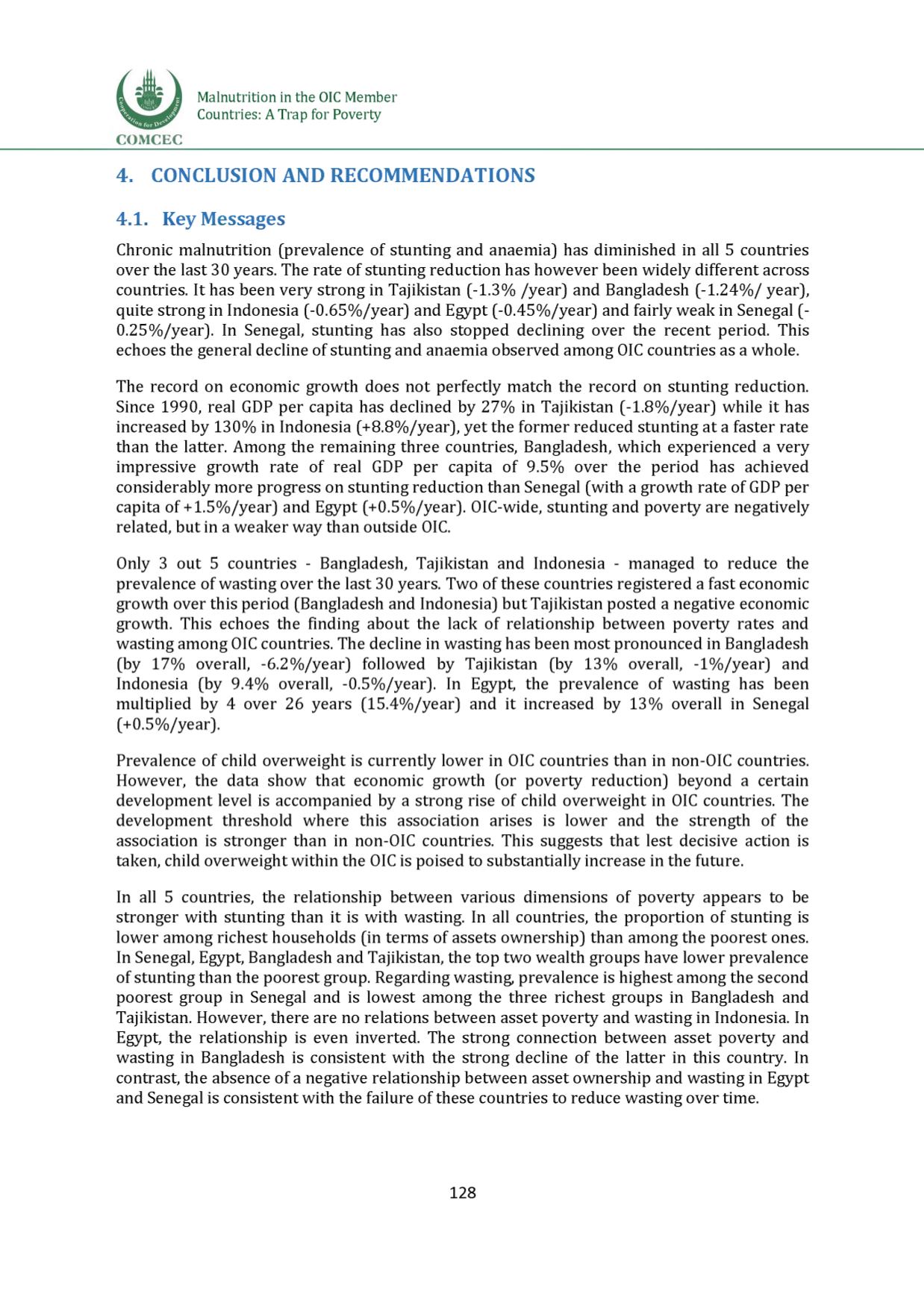

COMCEC
Malnutrition in the OIC Member
Countries: A Trap for Poverty
4 . CONCLUSION AND RECOMMENDATIONS
4 .1 . Key Messages
Chronic malnutrition (prevalence of stunting and anaemia) has diminished in all 5 countries
over the last 30 years. The rate of stunting reduction has however been widely different across
countries. It has been very strong in Tajikistan (-1.3% /year) and Bangladesh (-1.24%/ year),
quite strong in Indonesia (-0.65%/year) and Egypt (-0.45%/year) and fairly weak in Senegal (-
0.25%/year). In Senegal, stunting has also stopped declining over the recent period. This
echoes the general decline of stunting and anaemia observed among OIC countries as a whole.
The record on economic growth does not perfectly match the record on stunting reduction.
Since 1990, real GDP per capita has declined by 27% in Tajikistan (-1.8%/year) while it has
increased by 130% in Indonesia (+
8
.
8
%/year), yet the former reduced stunting at a faster rate
than the latter. Among the remaining three countries, Bangladesh, which experienced a very
impressive growth rate of real GDP per capita of 9.5% over the period has achieved
considerably more progress on stunting reduction than Senegal (with a growth rate of GDP per
capita of +1.5%/year) and Egypt (+0.5%/year). OIC-wide, stunting and poverty are negatively
related, but in a weaker way than outside OIC.
Only 3 out 5 countries - Bangladesh, Tajikistan and Indonesia - managed to reduce the
prevalence of wasting over the last 30 years. Two of these countries registered a fast economic
growth over this period (Bangladesh and Indonesia) but Tajikistan posted a negative economic
growth. This echoes the finding about the lack of relationship between poverty rates and
wasting among OIC countries. The decline in wasting has been most pronounced in Bangladesh
(by 17% overall, -6.2%/year) followed by Tajikistan (by 13% overall, -1%/year) and
Indonesia (by 9.4% overall, -0.5%/year). In Egypt, the prevalence of wasting has been
multiplied by 4 over 26 years (15.4%/year) and it increased by 13% overall in Senegal
(+0.5%/year).
Prevalence of child overweight is currently lower in OIC countries than in non-OIC countries.
However, the data show that economic growth (or poverty reduction) beyond a certain
development level is accompanied by a strong rise of child overweight in OIC countries. The
development threshold where this association arises is lower and the strength of the
association is stronger than in non-OIC countries. This suggests that lest decisive action is
taken, child overweight within the OIC is poised to substantially increase in the future.
In all 5 countries, the relationship between various dimensions of poverty appears to be
stronger with stunting than it is with wasting. In all countries, the proportion of stunting is
lower among richest households (in terms of assets ownership) than among the poorest ones.
In Senegal, Egypt, Bangladesh and Tajikistan, the top two wealth groups have lower prevalence
of stunting than the poorest group. Regarding wasting, prevalence is highest among the second
poorest group in Senegal and is lowest among the three richest groups in Bangladesh and
Tajikistan. However, there are no relations between asset poverty and wasting in Indonesia. In
Egypt, the relationship is even inverted. The strong connection between asset poverty and
wasting in Bangladesh is consistent with the strong decline of the latter in this country. In
contrast, the absence of a negative relationship between asset ownership and wasting in Egypt
and Senegal is consistent with the failure of these countries to reduce wasting over time.
128
















